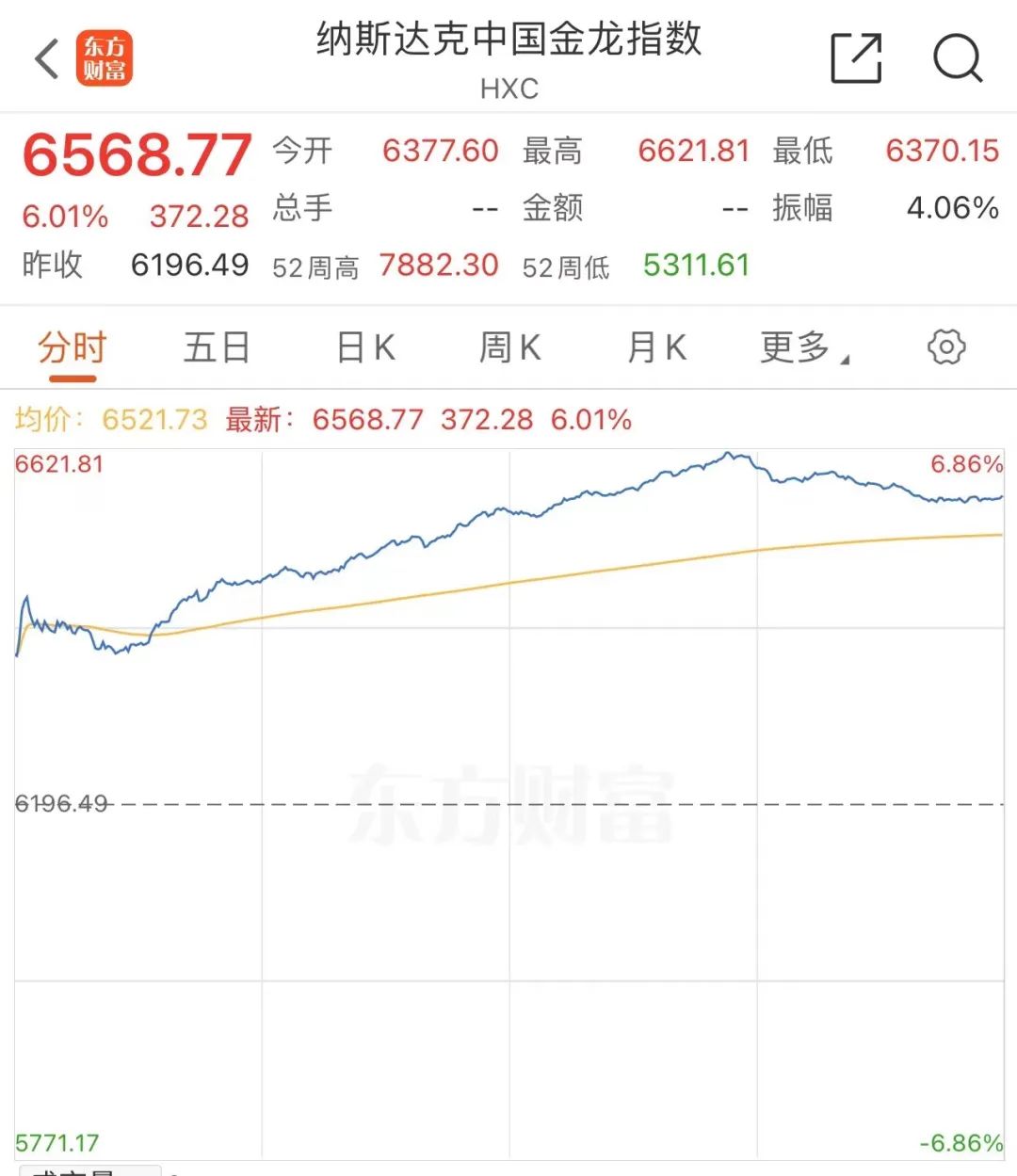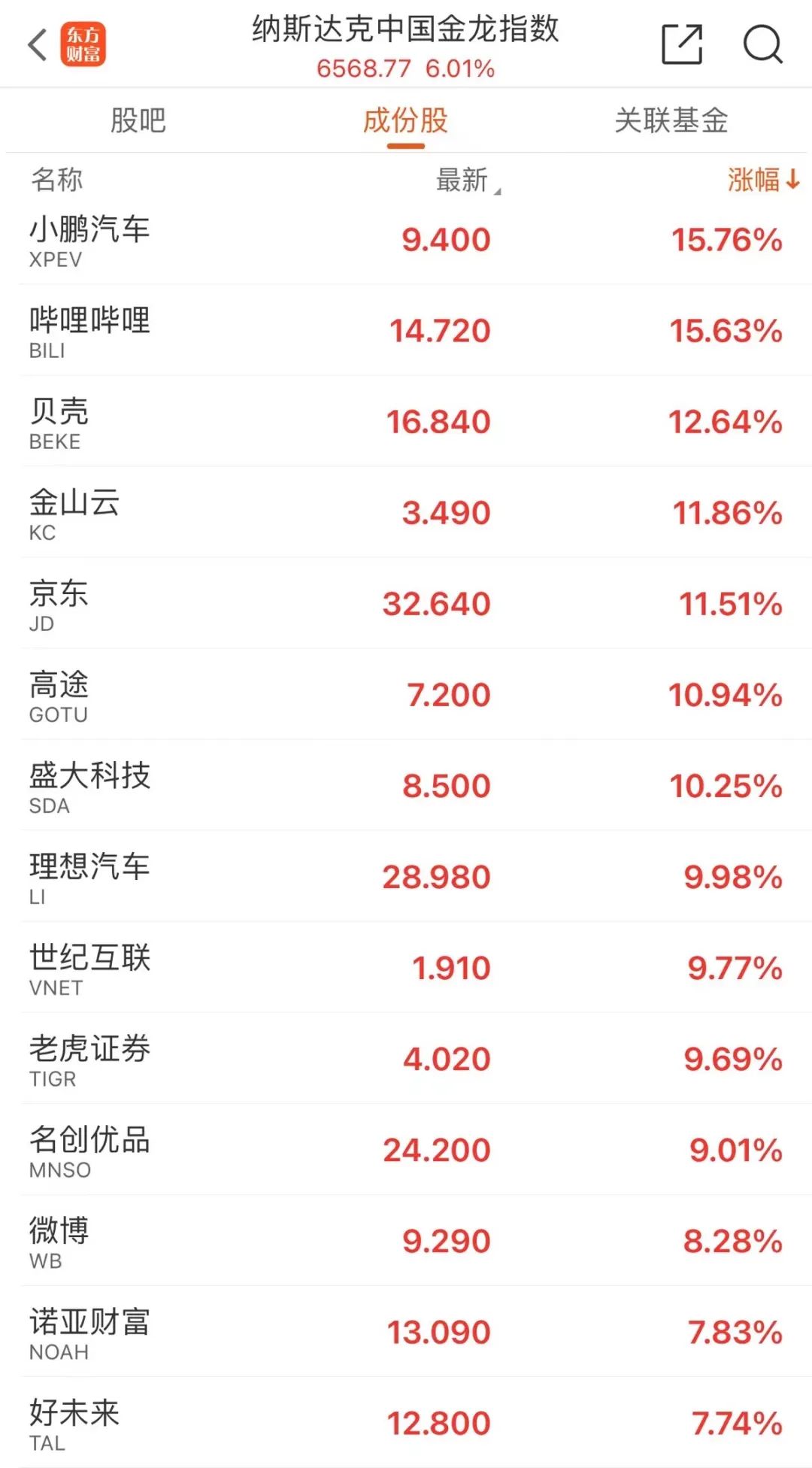Transfer from: Securities Times
China's assets "exploded"!
On the evening of May 2, US stocks collectively opened high. By the end of the day, the three major indexes had collectively closed higher, with the Nasdaq up 1.51%, the SP 500 up 0.91%, and the Dow up 0.85%.
The performance of China concept stocks was particularly strong. The NASDAQ China Golden Dragon Index rose by more than 6%, a new closing high since the end of November last year, and the largest one-day increase since the end of July last year.
In addition, recently, the yen began to depreciate at an accelerated rate. On May 2, the dollar fell below 154 per day. As of press release, the dollar was at 153.17 against the yen. The yen exchange rate fell to 160 yen per dollar on April 29, a 34 year low. Subsequently, the Japanese government intervened in the exchange rate by buying yen and selling dollars, costing 9 trillion yen twice. Even so, the market's sentiment of bearish yen is still high, because after two interventions, Japan's follow-up action will be significantly limited. The former governor of the Bank of Japan, Hideki Kuroda, said on Thursday that he expected the depreciation of the yen to be "only temporary", and the weakness of the yen would help improve corporate profits of Japanese multinational companies.
China's assets soared late at night
On the evening of May 2, US stocks collectively opened high. By the end of the day, the three major indexes had collectively closed higher, with the Nasdaq up 1.51%, the SP 500 up 0.91%, and the Dow up 0.85%. Large technology stocks rose generally, Nvidia and Amazon rose more than 3%, Netflix and Apple rose more than 2%, Google rose more than 1%, and Microsoft, Meta, Intel and Tesla rose slightly. On the news side, on May 2, the U.S. Department of Labor released data that the number of people who applied for unemployment benefits for the first time last week as of April 27 was 208000, estimated to be 215000, compared with 207000 at the beginning of the previous week and 208000 at the revised value. In addition, the US Department of Commerce reported that the US trade deficit in March was US $69.4 billion, the expected deficit was US $69.1 billion, and the previous deficit was US $68.9 billion. Among them, the export value was US $257.6 billion, the former value was US $263 billion; Imports were 327 billion US dollars, with a previous value of 331.9 billion US dollars.
China concept stocks performed strongly. The NASDAQ China Golden Dragon Index rose by more than 6%, a new closing high since the end of November last year, and the largest one-day increase since the end of July last year.
Xiaopeng Auto, Bilibili, Shell, Jinshan Cloud and Jingdong, Gaotu and Ideals Auto, Weibo, Baidu and TAL, Weilai and Alibaba, respectively, rose more than 15%, 12%, 11%, 10%, 8%, 7%, 6%, respectively.
It is worth mentioning that during the day of May 2, Hong Kong shares got off to a good start in May. On the same day, the Hang Seng Index rose 2.50%, and the Hang Seng Technology Index rose 4.45%.
Japan intervened in the exchange rate twice, costing 9 trillion yen
Japan's actions in the foreign exchange market have attracted much attention recently. Japan intervened in the foreign exchange market twice a week. With the rapid rise of the yen exchange rate within a few minutes, it shows that the Japanese authorities have intervened, and the market estimate is 9 trillion yen.
On April 29, the exchange rate of the yen against the dollar fell to 160 yen against the dollar, the first time since 1990. On the same day, the Japanese yen rose 1.25% to close at 156.34 under the Japanese official intervention in the foreign exchange market for the first time. On May 1, the yen exchange rate rose sharply again by 2.05% to close at 154.56. On May 2, the yen exchange rate fell below 154 within the day. As of press release, report 153.17.
According to the Bank of Japan's account data, Japan conducted its second yen intervention on May 2 this Thursday, with the intervention scale of 3.5 trillion yen. Previously, Japan may have intervened in the yen exchange rate on Monday (April 29), which is the first official intervention in the foreign exchange market since 2022. The intervention scale is about 5.5 trillion yen. The total amount of the two is about 9 trillion yen.
After two rounds of suspected intervention this week, the Japanese authorities' efforts to keep the yen strong have basically failed. At present, traders are preparing for the Bank of Japan's repeated intervention during the golden week holiday on May 3 and 6. Among them, May 6 will receive special attention. Because the London stock market will also be closed for the holiday, this may reduce the liquidity of the market (liquidity tends to exaggerate the changes in the exchange rate). The Japanese authorities may also take action if the closely watched US employment data on Friday boost the US dollar and further drag down the yen.
The former governor of the Bank of Japan, Hideki Kuroda, said on Thursday that he expected the depreciation of the yen to be "only temporary", and the weakness of the yen would help improve corporate profits of Japanese multinational companies. "I think the depreciation of the yen is only temporary, but people may have different views. If the depreciation of the yen is only temporary, in this case, the current Japanese stock price is inflated to some extent due to the temporary depreciation of the yen," Kuroda said. Kuroda's speech comes as Japanese policymakers may intervene in the foreign exchange market twice this week to support the yen after it fell to a 34 year low on Monday. Kuroda said: "I am confident of normalizing monetary policy in a very cautious way."
Market bearish yen sentiment remains high
The yen has become the victim of the widening interest rate gap between Japan and the United States. Even the speculation about the intervention of the Japanese government to support the yen is not enough to completely calm the bearish sentiment. At present, the interest rate gap between the United States and Japan is at a high of 3.7 percentage points, and foreign exchange intervention cannot reverse the huge interest rate gap, unless there is a clear indication that the Federal Reserve will begin to cut interest rates.
Since the Japanese government intervened in September 2022, the exchange rate of the yen against the US dollar has fallen by 8%, when the US Japan interest margin was close to 3 percentage points. At that time, when the Ministry of Finance of Japan intervened, the yen exchange rate remained near the 145.9 level, but since then the yen has depreciated again and exceeded this level. In 2022, Japan has intervened in the foreign exchange market three times (September 22, October 21 and October 24), with a capital scale of 9 trillion yen.
JPMorgan Chase said that in theory, Japanese officials can use all foreign exchange reserves to intervene, but in practice it is unlikely; In terms of intervention frequency, Japan can only carry out three series of interventions within six months or at most, otherwise it may lose its status as a "free floating" country.
The agency that most accurately predicted the yen said that although the Japanese authorities may try to curb the decline of the local currency, the yen may fall to 165 against the dollar. Alvin Tan, head of Asian foreign exchange strategy at RBC Capital Markets, predicted that the yen might fall to its lowest level since 1986. The main reason for the weakening of the yen is the huge interest margin between the United States and Japan. Even if the market has expectations for the possible intervention of the Bank of Japan, it is not enough to completely calm the bearish sentiment. Tan said that the intervention would be effective only if coordinated and coordinated by the United States. This year, investors may push up the dollar against the yen, and the exchange rate will once again break 160, reaching about 165.
It is worth noting that the rapid depreciation of the yen originated on April 10. At that time, during the visit of Japanese Prime Minister Takeo Kishida to the United States, the leaders of the United States and Japan issued a joint statement saying that the strategic cooperation between the United States and Japan ushered in a "new era" and that it was necessary to maintain the "international order based on the rule of law". Biden described the meeting as "the most important upgrade of the US Japan alliance since its establishment".
As a result, Japan is paying the bill for Kishida's high-profile visit to the United States. In the past, Japanese exporters preferred a weaker yen, but in the past two years, Japanese exports did not get an unexpected boost when the yen devalued significantly.
In addition to intervening in the exchange rate, Japan can also choose to raise interest rates. Indonesia has raised interest rates on April 24. But for Japan, raising interest rates is still a difficult choice. According to data, Japan's total debt will reach a record 1286.45 trillion yen in 2023, and the size of Japanese government bonds has accounted for about 260% of GDP. Under such circumstances, raising interest rates will lead to a corresponding increase in the national debt tax in Japan's financial budget, which will put greater financial pressure on the Japanese government.
Massive information, accurate interpretation, all in Sina Finance APP







